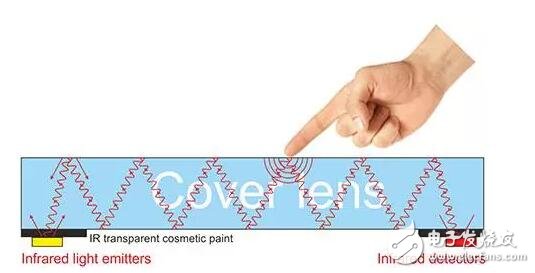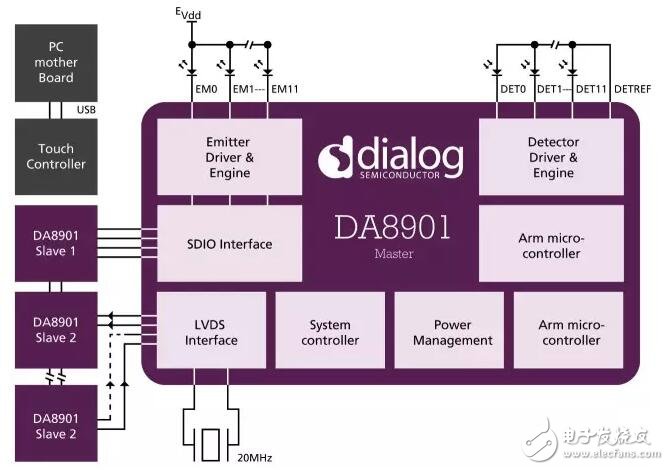The multi-touch interface has revolutionized the computer user interface, but at the moment we only see their potential to be used in simple touch interfaces or in applications where digitalization is beginning to take place, and applications that need to support large display panel touch interactions are just Start.
Multi-touch technology-based signage and billboards provide a new way for advertisers to interact with potential customers, enabling customers to rotate product images displayed on displays at the end of the store or on large outdoor display panels And scaling operations. At school, teachers and students can switch from the original simple whiteboard to an interactive display, which allows them to search for images and text online, then zoom in and add notes for use by others in the classroom.
In industrial and other real-time control applications, multi-touch makes it possible to include more control functions on the touch screen, allowing the operator to highlight the target on the screen, view the details, and then dial in the new one. Parameters without having to enter detailed commands or find relevant control function keys in the numerous function keys of the nearby Control Panel.

Figure 1: The DA8901 drives a series of infrared light-emitting diodes (LEs) in a controlled sequence to direct light into the cover glass of the display.
In the medical field, surgeons can use gestures to rotate and zoom tomographic images to better view areas of the image that need to be carefully examined to aid in diagnosing or accurately marking the surgical field.
This technology even enables furniture to have interactive capabilities. Many universities and companies, including Microsoft, are working on interactive surfaces for tables that not only detect the touches of users sitting around the table, but also detect objects placed on the table. This feature helps enhance Realistic games and other forms of entertainment.
However, these applications can only be implemented with the help of appropriate technology. Projected capacitive touch screens are driving the multi-touch technology revolution in portable electronic devices such as mobile phones and tablets, but the technology is not well suited for applications other than these applications. One of the problems is the ability to scale to larger screens. As the screen size increases, the accuracy of the technology is reduced and cannot be used for displays larger than 65 inches for whiteboards and interactive signage.
Another issue is the nature of the touch itself. Capacitive touch technology requires some capacitance of the touch object to record the touch action by the sensor. A bare finger or a specially designed stylus can meet this requirement, but a gloved finger may not be detected unless the glove is very thin. The technology also does not function properly in wet environments, making it difficult to use in outdoor signage and medical, industrial, and home desktop environments where liquid spills are prone to occur.

Figure 2: The size of the TV, similar to a tablet, with a flat, edge-to-edge display and a curved display.
In-glass multi-touch technology provides an alternative to meet all of these applications. The technique uses this principle when a transparent material strikes its surface at an angle greater than the critical angle and the reflection coefficient of the medium above the surface is lower than the reflection coefficient of the material itself, allowing light to be reflected inside.
Developed by FlatFrog and implemented by Dialog Semiconductor in the DA8901 Smartwave Multi-Touch Integrated Circuit (MTIC), an array of LEDs directs infrared light into the cover on the display at an oblique angle. Most of this light will reflect into the glass or plastic cover when it reaches the opposite side. The detector is placed in position to receive light that is reflected multiple times inside the cover (Figure 1).
If an object touches these surfaces, the internal reflections are disturbed, and the infrared light is scattered into the cover, and the detector that could receive them cannot receive the signal. This change in light intensity is recorded, amplified, and dynamically filtered by all affected detectors to eliminate the effects of ambient light and then converted to digital touch signals by high linearity analog-to-digital converters and dedicated touch algorithms.
An important aspect of in-glass sensing technology is its sensitivity to pressure: the expansion of the finger while pressing down more forcefully is detected as a further change in light intensity. Therefore, this technology provides smooth and responsive pressure sensing across the display. Because the technique relies on internal reflections, it doesn't matter if the display is flat or curved (Figure 2). This enables OEMs to take advantage of the curved display technology developed for large-screen TVs and makes it easier to touch the entire surface of the display when interacting with the system through touch.

Figure 3: Block diagram of the DA8901
Because light reflection is completely altered by the action of touching the physical object of the screen, in-glass technology can detect anything that touches it, in contrast to a projected capacitive system. At the same time, unlike the edge of the previous matrix infrared touch screen where the sensor and transmitter are mounted on the display panel and its cover, the in-glass technology supports full multi-touch sensing and can sense contact or placement on the display surface. Many objects.
At the same time, the control electronics can perform many functions, such as palm ignoring, to avoid recording "false" touches, such as when the user interacts with the system with their fingers, other parts of the hand are accidentally touched on the display. By adjusting the angle of some of the infrared emitters, it is possible to detect a close motion above the surface of the display by reflecting light from the target into the cover. This provides another layer of support for gesture recognition. For example, a user can 'flip' a set of images by waving a hand or finger at a close distance above the surface of the screen, as if the images were stacked in a book. More advanced motion processing also captures a wide range of gestures, opening up many ways for users to interact with large displays.
Supports active stylus implementation, communication via protocols such as Bluetooth, allowing precise use of sketches and maps. Based on the accuracy of this touch technology core - providing up to 400dpi resolution, the various controls on the stylus allow the user to selectively draw, edit and control points on the display.
In-glass technology can be used in environments where liquid spills or build-up can occur. Because all of the sensing electronics are behind the cover, the touch screen can be placed inside a fully sealed housing, protected from contaminants such as dust and water, while still being able to detect touches caused by physical objects.
Since the electronic components are connected to the cover glass or plastic sheets placed on top of the actual display module, the in-glass technology is easily combined with standard displays to provide a professional system for major vertical applications such as signage and industrial control. Adoption of integrators.
This technology has some other advantages over typical touch screen technology. Since it uses only infrared light that cannot be distinguished by the human eye and does not rely on a thin metal mesh to provide the function of the touch electrode, light transmission and sharpness and contrast are improved. Again, this technology has excellent resistance to electrical noise, which is an important factor in industrial applications.
Its core technology also has excellent shock and vibration resistance. In combination with a sufficiently strong cover layer, in-glass technology can be used in situations where accidental damage or vandalism can occur.
Thanks to its rich combination of features, in-glass multi-touch technology will drive a new wave of applications – especially for systems that require large display areas, and revolutionize user interface development in many industries and markets.
We are a specialist automation systems integrator with our own well-equipped workshop for building electrical and industrial control panels. Our team use the very latest design and project software, to ensure traceability throughout all steps of the manufacturing process. We constantly invest in the latest electrical control system building equipment, tools, and software.
Every control system is designed to suit your specific application; using only the very best components from leading manufacturers. We are happy to build control panels from your own electrical schematics, or alternatively
Marine Control Box are strictly complying with the Marine standard and all the components are Marine Classification Certified.
Sound electrical design principles are the foundation of every industrial control panel we build. We use the very latest electrical design software, including ePlan Pro Panel Professional. Our engineers use Solidworks for 3D modeling of components and laser cutting our panel doors.
Being a quality driven firm, we do hard work to serve our customers in a well-systematized & successful way by presenting the optimum grade services. Our offered services are rendered by a crew of creative and talented personnel. We provide these services in accordance with the prevailing industry guidelines and set principles by using contemporary technology. In addition to this, offered services are highly in demand in the market for their outstanding features such as cost effectiveness, hassle free management and timely execution.
Witch Control Board,Hoist Motor Control Box,Car Hoist Control Box ,Stacker Control Box
Nantong Double Star Automation Equipment Co., Ltd. , https://www.nt-doublestar.com